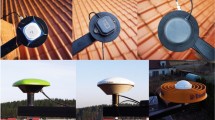Abstract
This paper presents a new Geographic Information Systems (GIS) tool to compute the optimal solar-panel positioning maps on large high-resolution Digital Elevation Models (DEMs). In particular, this software finds out (1) the maximum solar energy input that can be captured on a surface located at a specific height on each point of the DEM, and then (2) the optimal tilt and orientation that allow capturing this amount of energy. The radiation and horizon algorithms we developed in previous works were used as baseline for this tool (Romero et al. in Comput. Phys. Commun. 178(11):800–808, 2008; Tabik et al. in Int. J. Geogr. Inf. Sci. 25(4):541–555, 2011). A multi-method approach is analyzed to make the hybrid implementation of this tool especially appropriate for heterogeneous multicore-GPU architectures. The experimental results show a high numerical accuracy with a linear scalability.



Similar content being viewed by others
References
Hofierka J, Kanuk J (2009) Assessment of photovoltaic potential in urban areas using open-source solar radiation tools. Renew Energy 34(10):2206–2214
Cellura M, Di Gangi A, Longo S, Orioli A (2012) Photovoltaic electricity scenario analysis in urban contests: an Italian case study. Renew Sustain Energy Rev 16(4):2041–2052
Choi Y, Rayl J, Tammineedi C, Brownson JRS (2011) PV analyst: coupling ArcGIS with TRNSYS to assess distributed photovoltaic potential in urban areas. Sol Energy 85(11):2924–2939
Bari S (2000) Optimum slope angle and orientation of solar collectors for different periods of possible utilization. Energy Convers Manag 41(8):855–860
Bakirci K (2012) General models for optimum tilt angles of solar panels: Turkey case study. Renew Sustain Energy Rev 16(8):6149–6159
Jafarkazemi F, Saadabadi SA (2012, in press) Optimum tilt angle and orientation of solar surfaces in Abu Dhabi, UAE. Renew Energy
ESRI (2011) ArcGIS Desktop: Release 10. Redlands, CA: Environmental Systems Research Institute
Suri M, Hofierka J (2004) A new GIS-based solar radiation model and its application to photovoltaic assessments. Trans GIS 8:175–190
GRASS Development Team (2012) Geographic resources analysis support system (GRASS) software. Open source geospatial foundation project. http://grass.osgeo.org
Romero LF, Tabik S, Vias J, Zapata EL (2008) Fast clear-sky solar irradiation computation for very large digital elevation models. Comput Phys Commun 178(11):800–808
Tabik S, Vias JM, Zapata E, Romero LF (2007) Fast Insolation Computation in Large Territories. In: International conference on computational science, vol 1, pp 54–61
Tabik S, Romero LF, Zapata EL (2011) High-performance three-horizon composition algorithm for large-scale terrains. Int J Geogr Inf Sci 25(4):541–555
Tabik S, Villegas A, Zapata EL, Romero LF (2012) A fast GIS-tool to compute the maximum solar energy on very large terrains. Proc Comput Sci 9:364–372
NVIDIA CUDA C programming guide. Available from URL. http://docs.nvidia.com/cuda/index.html
Acknowledgements
This work was supported by the Spanish Ministry of Science and Innovation TIN2010-16144 and the postdoc grant funded by the University of Málaga. We thank Nvidia for hardware donation under Professor Partnership 2008–2010, CUDA Teaching Center 2011–2012 and CUDA Research Center 2012 Awards.
Author information
Authors and Affiliations
Corresponding author
Rights and permissions
About this article
Cite this article
Tabik, S., Villegas, A., Zapata, E.L. et al. Optimal tilt and orientation maps: a multi-algorithm approach for heterogeneous multicore-GPU systems. J Supercomput 66, 135–147 (2013). https://doi.org/10.1007/s11227-013-0891-1
Published:
Issue Date:
DOI: https://doi.org/10.1007/s11227-013-0891-1




